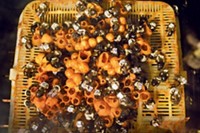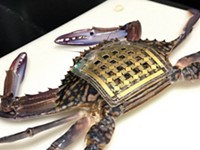Advertisement
Grab your lab coat. Let's get started
Welcome!
Welcome!
Create an account below to get 6 C&EN articles per month, receive newsletters and more - all free.
It seems this is your first time logging in online. Please enter the following information to continue.
As an ACS member you automatically get access to this site. All we need is few more details to create your reading experience.
Not you? Sign in with a different account.
Not you? Sign in with a different account.
ERROR 1
ERROR 1
ERROR 2
ERROR 2
ERROR 2
ERROR 2
ERROR 2
Password and Confirm password must match.
If you have an ACS member number, please enter it here so we can link this account to your membership. (optional)
ERROR 2
ACS values your privacy. By submitting your information, you are gaining access to C&EN and subscribing to our weekly newsletter. We use the information you provide to make your reading experience better, and we will never sell your data to third party members.
Astrochemistry
Newscripts
Industrious bees fill in for coworkers, inspire Mars mission
by Alexandra Taylor
April 29, 2018
| A version of this story appeared in
Volume 96, Issue 18
The secret life of bees, exposed

While studying bumblebees (Bombus impatiens), James Crall and his team at Harvard University were stung by the individual differences in the bees’ foraging behavior—for example, some bees wake up early every day to go collect food, while others prefer to sleep in. That observation led them to wonder what happens when the hardest workers are temporarily removed (Nat. Commun. 2018, DOI: 10.1038/s41467-018-03561-w). Would other bees step in to fill their teeny-tiny shoes, and if so, how?
To answer this question, Crall’s team needed to peer inside the nest to closely monitor the bees’ behavior, so they used the BEEtag system. They cut out close to 2,000 minuscule QR codes printed on waterproof paper to affix to the bees’ backs. “That’s definitely the most laborious part of the process,” Crall tells Newscripts. They anesthetized the bees by cooling them in a fridge, attached the QR codes with a tiny dab of superglue between their wings, and warmed them back up. After about an hour, “you have a whole buzzing colony raring to go again,” Crall says.
For 24/7 monitoring, the team built a laser-cut plastic box about the size of a natural bumblebee nest. They moved the nest into the box, which had a clear top that allowed them to film the bees’ behavior. A clear plastic tunnel fitted with a motion-sensing camera allowed the researchers to track individual bees as they left to forage. They illuminated the setup with red light, which bees can’t see well, to avoid disrupting their behavior.
The team found that bumblebees share tasks, such as cleaning, foraging, and nursing, but most bees spend most of their time on one of those tasks. When the researchers removed the most active foragers, the colony replaced them within 48 hours. The bees who liked to hang out near where the nectar is stored were more likely to switch to foraging when the active foragers went AWOL. Crall hypothesizes that because these bees are the ones most likely to notice that food is running low, they are the ones who run out to get more.
Crall was surprised by the strength of the bees’ individual personalities and by how physical traits, such as body size, seem to barely affect whether a bee will step in as a forager. Next, he hopes to use this technique to determine how pesticides such as neonicotinoids disrupt bumblebee colony behavior.
Flight of the Marsbees

While the bumblebee as we know it is currently confined to Earth, a team of forward-thinking scientists is pretty sure they can make something similar fly on Mars. Chang-kwon Kang of the University of Alabama, Huntsville, and colleagues have devised a fleet of Marsbees—bumblebee-sized flapping fliers with cicada-like wings—to gather information on the red planet. The robots would be equipped with sensors and mobile communication devices to transmit data back to a mobile base, which would serve as the recharging station and communication hub. The Marsbees would help map the terrain and measure the temperature, pressure, and chemical makeup on Mars.
Advertisement
The team’s concept won a 2018 NASA Innovative Advanced Concepts award. The prize provides funding for phase I of development, in which the researchers will determine the proper wing design, motion, and weight for martian conditions. Mars’s atmosphere has a lower density than the one we’re used to, so it’s not enough to simply transplant a winged robot from Earth. If all goes well over the next nine months, the team can spread its wings and apply for phase II funding.
Alexandra Taylor wrote this week’s column. Please send comments and suggestions to newscripts@acs.org.





Join the conversation
Contact the reporter
Submit a Letter to the Editor for publication
Engage with us on Twitter